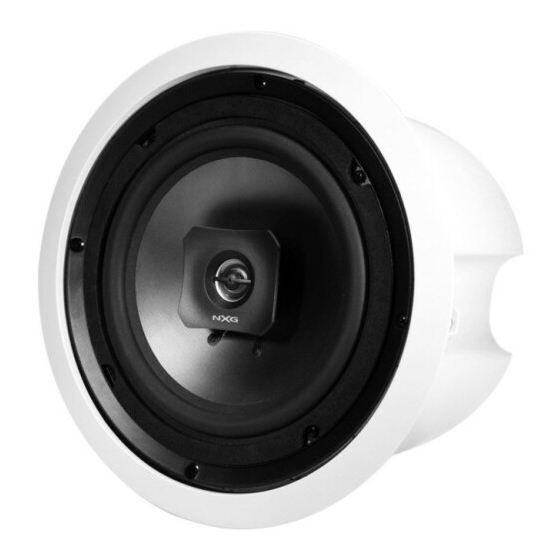
Table of Contents
Advertisement
Quick Links
NX-C8.2-ENC-X 8˝ Two-Way In-Ceiling Enclosed Speaker System
Congratulations on choosing NXG In-Ceiling
Loudspeakers. Like all NXG products, great
care has been taken in their design. Their
combination of advanced engineering and
state-of-the-art materials will provide you with
years of listening pleasure, while blending
smoothly into your home's decor. Before you
get started, it is a good idea to identify all the
parts and hardware (See Fig. 1).
Where To Place Your In-Ceiling Speakers
Placement can make all the difference in how your speakers sound, and how easy they will be to
install. Carefully consider where your speakers should be positioned. For optimum performance,
speakers should be mounted to the left and right of the main listening area and a minimum of 8
to 10 feet apart (See Fig. 2). Avoid mounting speakers in stud cavities containing electrical wiring,
heating ducts, water pipes, etc. Make sure the ceiling materials are sturdy enough to support the
weight of the speakers.
Adjustable Tweeters
(Fig. 3)
The tweeter in your NXG speaker may be adjusted, allowing you to tailor the speaker to better fit
the listening area. The overall smoothest response is achieved with the tweeter facing straight out:
however, you may find the sound more pleasing by aiming tweeters toward a particular listening
area. To adjust the tweeter, grasp the outside of the tweeter plate and gently pivot it toward the
listening area.
Speaker Installation In Existing Construction
Once you have selected the location for your speakers, you are ready to install them.
You will need the following:
• Stud Finder
• Drill & Drill Bits
• Pencil
• Phillips Screwdriver
NXG recommends the use of 16-gauge wire minimum. For wire options consult your retailer or
custom audio contractor.
1. NXG Architectural Speakers are designed to be installed in the ceiling or wall area between studs.
Using a stud finder, make sure you are between two studs. Tape the supplied template to the wall
and lightly trace around the inside with a pencil.
2. Cut the hole using your drywall saw. You may want to start with a small hole in the center of the
outline. This will allow you to check for any obstructions that may exist behind the desired location.
CAUTION: Be certain electrical wiring, water pipes or heating ducts do not interfere in the planned
installation areas prior to drilling or cutting the wall.
3. Run speaker wire from your amplifier or speaker switching device to the speaker location.
4. Carefully remove the grille and inner grille backing. (Note: The open cell foam inner grille backing
is designed to hide speaker components from view and may be removed if desired.) If you like the
standard white finish of your NXG speakers, skip to step 5, but if if you want your speakers to blend
in with a colored wall or ceiling, now is the time to paint your speaker's outer frame and perforated
grille. (Remove the foam inner grille backing and put it aside in a clean and dust free area for later
reinstallation if desired.) The speaker's outer surface will accept ordinary latex wall paint or aerosol
spray paint. Because the speaker baffle surface behind the grille should remain unpainted, you will
need to cover this area with the supplied cardboard paint mask. Cover the speaker's interior black
surface, woofer and tweeter. Paint the outer speaker frame and grille separately. (Grille painting hint:
Use a paint roller that is nearly out of paint to first paint the inside of the grille, then the outside. This
will avoid paint filling the grille perforations.)
OWNER'S MANUAL
FIG. 1
Grille
removal
tool
Black
grille
adhesive
(See Fig. 4 on reverse)
• Wire Cutter/Strippers
• Utility Knife or Drywall Saw
(Continued on reverse)
Metal grille with foam
Speaker with self-contained
inner grille cover
mounting clamps
• Speaker Wire
• Masking Tape
Cutout
Painting mask
template
1
2
2
FIG. 2
1
NXG ceiling speakers can be used as rear
surround channels by mounting them
(1) on each side of, (2) just behind, or
(3) in back of the viewing position.
FIG. 3
Pivoting
tweeter
3
3
Advertisement
Table of Contents

Summary of Contents for Nxg NX-C8.2-ENC-X
- Page 1 If you like the standard white finish of your NXG speakers, skip to step 5, but if if you want your speakers to blend in with a colored wall or ceiling, now is the time to paint your speaker’s outer frame and perforated grille.
- Page 2 Exclusion of Certain Damages lated staples only and be careful not to pierce the wire’s NXG’s liability for any defective product is limited to repair or replacement of the product at insulation. Allow a bit of slack for expansion of building our option.NXG shall not be liable for incidental or consequential damages of any kind or...








Need help?
Do you have a question about the NX-C8.2-ENC-X and is the answer not in the manual?
Questions and answers